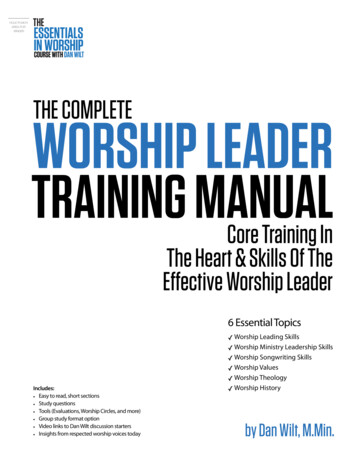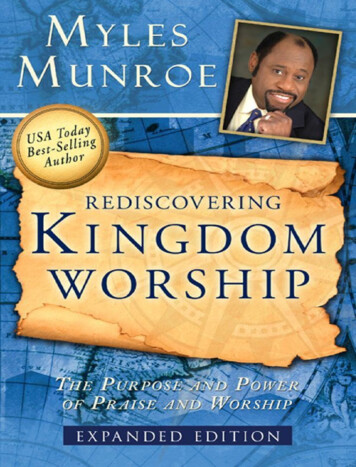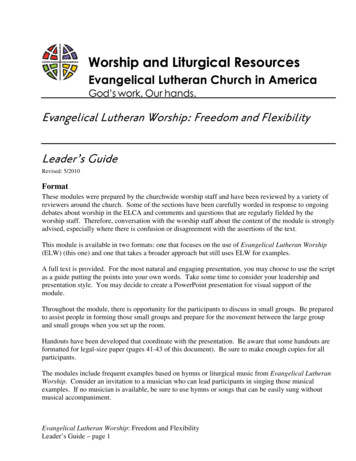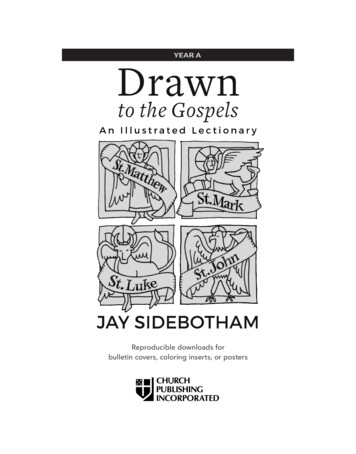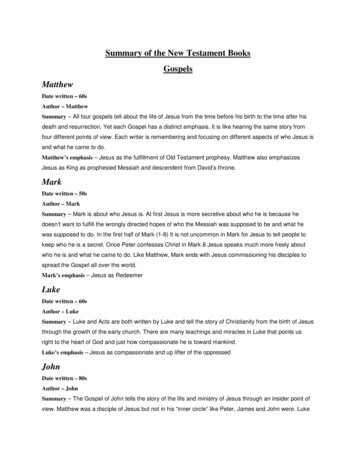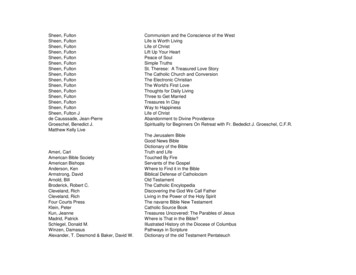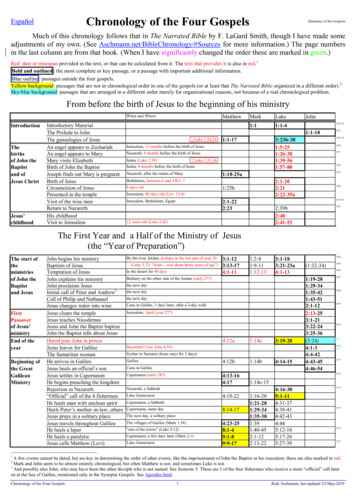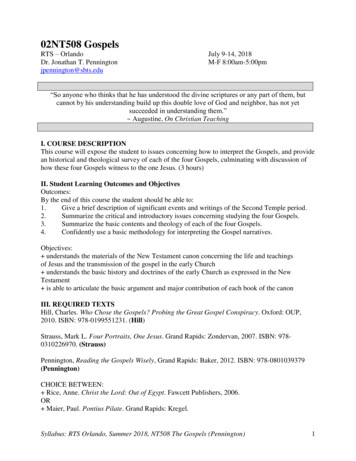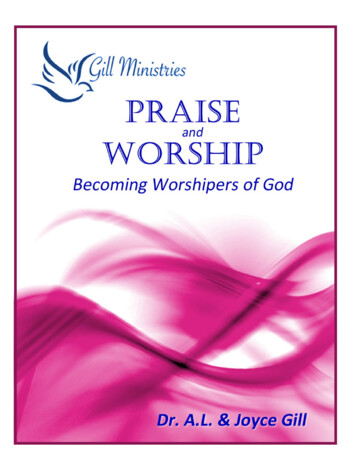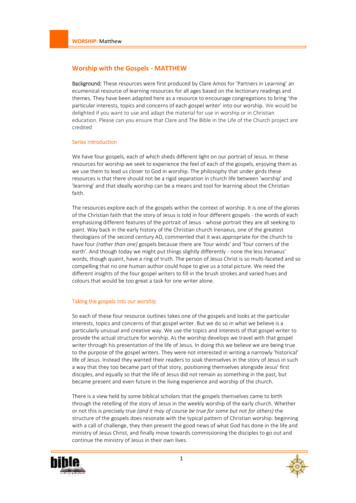
Transcription
WORSHIP: MatthewWorship with the Gospels - MATTHEWBackground: These resources were first produced by Clare Amos for ‘Partners in Learning’ anecumenical resource of learning resources for all ages based on the lectionary readings andthemes. They have been adapted here as a resource to encourage congregations to bring ‘theparticular interests, topics and concerns of each gospel writer’ into our worship. We would bedelighted if you want to use and adapt the material for use in worship or in Christianeducation. Please can you ensure that Clare and The Bible in the Life of the Church project arecreditedSeries IntroductionWe have four gospels, each of which sheds different light on our portrait of Jesus. In theseresources for worship we seek to experience the feel of each of the gospels, enjoying them aswe use them to lead us closer to God in worship. The philosophy that under girds theseresources is that there should not be a rigid separation in church life between 'worship' and'learning' and that ideally worship can be a means and tool for learning about the Christianfaith.The resources explore each of the gospels within the context of worship. It is one of the gloriesof the Christian faith that the story of Jesus is told in four different gospels - the words of eachemphasizing different features of the portrait of Jesus - whose portrait they are all seeking topaint. Way back in the early history of the Christian church Irenaeus, one of the greatesttheologians of the second century AD, commented that it was appropriate for the church tohave four (rather than one) gospels because there are 'four winds' and 'four corners of theearth'. And though today we might put things slightly differently - none the less Irenaeus'words, though quaint, have a ring of truth. The person of Jesus Christ is so multi-faceted and socompelling that no one human author could hope to give us a total picture. We need thedifferent insights of the four gospel writers to fill in the brush strokes and varied hues andcolours that would be too great a task for one writer alone.Taking the gospels into our worshipSo each of these four resource outlines takes one of the gospels and looks at the particularinterests, topics and concerns of that gospel writer. But we do so in what we believe is aparticularly unusual and creative way. We use the topics and interests of that gospel writer toprovide the actual structure for worship. As the worship develops we travel with that gospelwriter through his presentation of the life of Jesus. In doing this we believe we are being trueto the purpose of the gospel writers. They were not interested in writing a narrowly 'historical'life of Jesus. Instead they wanted their readers to soak themselves in the story of Jesus in sucha way that they too became part of that story, positioning themselves alongside Jesus' firstdisciples, and equally so that the life of Jesus did not remain as something in the past, butbecame present and even future in the living experience and worship of the church.There is a view held by some biblical scholars that the gospels themselves came to birththrough the retelling of the story of Jesus in the weekly worship of the early church. Whetheror not this is precisely true (and it may of course be true for some but not for others) thestructure of the gospels does resonate with the typical pattern of Christian worship: beginningwith a call of challenge, they then present the good news of what God has done in the life andministry of Jesus Christ, and finally move towards commissioning the disciples to go out andcontinue the ministry of Jesus in their own lives.1
WORSHIP: MatthewWhat each writer tells us about the EucharistAt the heart of our worship, and a model established by Jesus himself, is the service ofCommunion or the Eucharist. So perhaps it is not surprising that as we explore the gospelsthrough worship we find ourselves led each week towards a celebration of Communion, andhave the chance to discover the distinctive insights that the individual gospel writers have toshare about this central act of Christian worship. In Mark we discover that Communion leads us back to remember more deeply thedeath of Christ and live the marks of the Cross in our own lives.In Luke we are encouraged to experience Communion as a sign of the hospitality andfellowship that friends of the risen Jesus are called to show to each other.In Matthew we are helped to understand that Communion also has a forward lookingemphasis - it is a foretaste of the heavenly feast with which God will one day feed allpeople.In John we see the church's celebration of Communion acts as a link between timeand eternity.The Communion focus of each week is not essential to the resources. Churches that would notwish to celebrate Communion each week can draw from the prayers and readings offered todevelop an interesting theme that can teach a great deal about the special concerns of each ofthe gospel writers. While these resources are primarily about the four gospels churches thatwish to explore together more deeply the meaning of Communion could also use them.Each ‘resource file’ provides an overview of the way the gospel writer was trying to get hismessage across; ideas and suggestions for how these ideas might be incorporated into aCommunion service; and suggestions for hymns, songs, prayers etc that might be used. As theoriginal writing was for the British churches there may be better material for your context.These outlines are offered with the invitation to adapt them to your situation so that,wherever we are, we might hear Scripture speaking into our context more clearly. Clare Amos2
WORSHIP: MatthewMatthew – Feast on the MountainOverview of Matthew’s GospelWhen Clare (the writer) spent a year in 1980 at Queens, the ecumenical theological college inBirmingham, England there were two features of Methodist worship that made a particularimpact on her as an Anglican. The first was the importance of Charles Wesley hymns in thecontext of Methodist worship, the second was a particular emphasis within the Eucharist thatMethodism seems to have taken more seriously than any other Christian tradition. Perhaps it ispartly due to the Methodist scholar Geoffrey Wainwright, and his key book 'Eucharist andEschatology'. At any rate the phrase 'a foretaste of the heavenly banquet prepared for allmankind (people)' used in the prayer after communion in Methodist service books has alwaysstuck in my mind and made me look at what communion may mean in a new and differentway.When we start to look at the gospel of Matthew this is also an emphasis we find. It is oftensuggested that Matthew is a gospel that is concerned to present the life and ministry of Jesusas the fulfilment of the past, of the Old Testament. That is certainly so, but one particular OldTestament theme that is at the heart of the gospel also encourages us to set our gaze towardsthe future. For one of the most exciting promises contained within the Old Testament is thatthere would one day come a time when God would invite all people, Jews and Gentiles, to afeast to be held on the mountain of God.At this feast all would have enough to eat, there would no longer be famine, or tears or death.At this feast, God himself would be present as the host. All people would be invited - althoughperhaps not all would wish to attend. Perhaps they might not wish to sit alongside some of theother guests, those unlikely people - the foreigners, the disabled, those less than morallyperfect - that God had chosen as his honoured guests, and so decide to refuse the invitation.Perhaps they might be so fearful of meeting God face to face, aware that God would be able to'see through' them and the facade of respectability they wished to present. So they refuse tocome to the feast: but that is their own choice. God's invitation was free and for all.For Matthew the image of this feast on God's mountain is a theme that underlies much of hisgospel. It is set out explicitly in Matthew 8.11 'Many will come from east and west and will eatwith Abraham and Isaac and Jacob in the kingdom of heaven'. It is implicit in the story of theSheep and the Goats (Matthew 25.31-46) even though in this story some eventually findthemselves excluded because of their attitude to their fellow guests! It resonates with theBeatitudes (Matthew 5.1-11) that almost feel like a pilgrimage song to be chanted on the wayto God's mountain. It is of course linked with the fact that mountains are important throughoutMatthew's gospel eg the Sermon on the Mount, Mount of transfiguration, Mount of Olives(Matthew 24), and the mountain of the final meeting with Jesus (Matthew 28.16-20). But thereis one other mountain of which Matthew speaks - and it is this that provides our key readingfor service.In Matthew 15.29-39 Jesus, while in Gentile territory, first goes up a mountain, then cures themultitude of the disabled who come to him, and then still on the mountain offers them food.The feast of the nations is beginning to come to fruition in the ministry of Jesus!What a strange pilgrim group to share in such a privileged occasion! Matthew was well awarethat those who wanted to visit God in the Jewish Temple had to be physically perfect. No blindor lame were ever allowed near the place (2 Samuel 5.6-8). It is only when you realise this, thatyou begin to understand just how radical the gospel of Matthew is here. It is almost as though3
WORSHIP: Matthewthe able-bodied only get invited to this feast if they are accompanying someone that Jewishtradition castigated as 'unclean'. (Incidentally Matthew is equally provocative at the verybeginning of his gospel - the only four women mentioned in the Old Testament genealogy ofJesus are all distinctly dubious!) Matthew the gospel writer is very concerned with 'holiness' but he also turns upside down what holiness conventionally meant!And did the pilgrim group meet God at this feast on the mountain as Isaiah 25.6 suggests? Ofcourse. For who else is Jesus but Immanuel, 'God with us', (Matthew 1.23), and who also onanother mountain at the end of the gospel said: 'I am with you always to the end of the age'.(Matthew 28.20)As the early church came to realise, however, that feast that had taken place on the mountainin the ministry of Jesus, was only an hors d'oeuvre, a taster, for a banquet of which the maincourse is yet to be. And for many in the early church (and Matthew himself was probably one)Communion was seen as the moment when members of the Christian community could eatand drink and themselves experience a 'foretaste' of this final banquet. The Didache, an earlyChristian document, that probably comes from a time and place fairly close to where and whenMatthew's gospel was written, contains a Communion prayer which is totally forward looking.It has no explicit reference at all to the death of Christ, and directs our attention to a futureingathering of people 'from the four winds'. It is this text from the Didache that we havesuggested could be used as the Communion prayer for this week. We have set out the text ofthis Didache version in full as it may not be easily accessible.Taking Matthew into our worship – some suggestionsTo sum up, it is a 'forward looking' feel that we are seeking to convey in worship as we explorethe dynamics of the gospel of Matthew. We are attempting to present, at least symbolically,the sense of people journeying to the 'feast on the mountain', humbled to find out who theirfellow pilgrims may be, discovering that we are all called to be 'holy'. Yet we also discoverholiness means something very different from what we have so often imagined it to be. Whenwe arrive at this mountain we are invited to feast, to eat and to drink, and we have the aweinspiring yet life giving opportunity to see God face to face.Then it will be time for us to depart, to come down from the mountain, and journey back asGod's messengers to east and west and north and south. But we shall never be alone again, forwe carry Jesus' promise in our hearts wherever we go: 'I am with you to the end of the age'.Call to worshipLeader: Who shall ascend the hill of the Lord?And who shall rise up in his holy place?People: Those who have clean hands and pure hearts,who do not lift up their souls to what is false,and do not swear deceitfully.They will receive blessing from the Lord,and vindication from the God of their salvation.(Psalm 24.3-5)Introduction to the worship4
WORSHIP: MatthewIntroduce the themes, bringing out the links with the 'feast on the mountain' theme. Then havethe following read, by someone standing near the altar/communion table.Bible reading - Isaiah 25.6-10a (.the hand of the Lord will rest on this mountain)Verses 9-10a could be repeated with all joining in from 'See, this is our God.'Reading/Activity: Including the outsidersHave two voices read the Beatitudes as they do have a number of individuals come forward oneby one and stand near to the table, each with a visible placard either held or around their neck.You can chose either from the list A or B or both.List A: Tamar, Rahab, Ruth, The wife of UriahList B: hungry, thirsty, a foreigner, naked, sick, in prsionWhen those bearing placards have reached the table, the leader asks if people can work outwho they are. List A comprises the Old Testament women mentioned in Matthew 1, all of whomwere 'odd'. List B are those who are the 'least of my brethren' in Matthew 25, and about whomJesus says that we stand or fall by our treatment of them.Then invite people to share in the following expression of penitence:Penitential (Use several voices for the specific comments, or say them together)Leader: Christ calls us to share the heavenly banquet of his lovewith all the saints in earth and heaven.Knowing our unworthiness and sin,let us ask from him both mercy and forgiveness. AmenVoice 1: I was hungry and you gave me no food,Voice 2: I was thirsty and you gave me no drink,All: Lord have mercy.Voice 3: was a stranger and you did not welcome me,Voice 4: naked and you did not clothe me.All: Lord have mercy.Voice 5: I was sick and you did not visit me,Voice 6: in prison and you did not come to me.All: Lord have mercy.Leader: Hear the gracious promise of Christ: Many will come from east and west and north andsouth and eat at my table in my kingdom.Representatives of the congregation now come from each of the four points of the compass.5
WORSHIP: MatthewEach group could bring appropriate symbols from their 'region ie north, south, east, west, whichcould be placed on the table. While this is happening 'Hills of the north' or a hymn with similarmeaning could be sung.Prayers of intercessionThe following prayers of intercession bring out well a number of key themes in Matthew'sgospel eg teaching, the ministry, mission and community, and link into the overall thrust of theservice. You might prefer to use them earlier or later in the worshipIn every age you have raised up holy men and women to reflect the light of Christ and to teachus the ways of holiness.We thank you for those who have been teachersin the school of Christ (especially Matthew):give understanding to those who studythe faith the Church has handed on,and clarity to those who communicate the gospelin a changing world.Response: Lord hear us,Lord graciously hear usWe thank you for those who have been shepherds of your people:give a pastoral heart to ministers and leaders of the flock,and the needful gifts to all your people in their ministry.ResponseWe thank you for those who have been Christian rulers in the world,and for those who carried the good newsto lands where it had not been before:give wisdom to all who have power and influence among the nations,and establish God's sovereignty among people of every race.ResponseWe thank you for those whom you have called to live in community:establish mutual love among those drawn into fellowship in your serviceand bless with Christ's presenceall the communities to which our lives relateResponseHasten Lord, the day when people will come from east and west,from north and south,and sit at table in your Kingdom,and we shall see your Son in his glory.Merciful FatherAccept these prayersfor the sake of your Sonour Saviour Jesus Christ.( 'Enriching the Christian Year ', Michael Perham, adapted, SPCK)6
WORSHIP: MatthewMove straight into the gospel reading.Gospel reading - Matthew 15.29-38After reading the gospel the reader turns to the congregation and offers the following invitationenthusiastically:Come on,Let us celebrate the supper of the Lord.Let us make a huge loaf of breadand let us bring abundant wine.Let the woman not forget the salt.Let the men bring along the yeast.Let many guests come,the lame, the blind, the crippled, the poor.Come quickly.Let us follow the recipe of the Lord.All of us, let us knead the dough togetherwith our hands.Let us see with joyhow the bread grows.Because todaywe celebratethe meeting with the Lord.Today we renew our commitment to the Kingdom.Nobody will stay hungry.( Elsa Tamez, slightly adapted)Communion prayerLeader: We give thanks to you, our Father, for the holy Vine of your servant David, which youhave made known to us through your servant Jesus. (bless cup)People: Glory to you, world without end.Leader: We give thanks to you, our Father, for the life and knowledge which you have madeknown to us through your servant Jesus.People: Glory to you, world without end.Leader: As this broken bread, once dispersed over the hills, was brought together and becameone loaf, so may your Church be brought together from the ends of the earth into yourkingdom. (bless bread)People: Yours is the glory and the power, through Jesus Christ, forever and ever.Leader: Thanks be to you, holy Father, for your sacred Name which you have made to dwell inour hearts, and for the knowledge and faith and everlasting life which you have revealed to usthrough your servant Jesus.People: Glory to you, forever and ever.7
WORSHIP: MatthewLeader: Almighty Lord, you have created all things for your own name's sake; to all people youhave given meat and drink to enjoy, that they may give thanks to you, but to us you havegraciously given spiritual meat and drink, together with life eternal, through your Servant.Especially and above all, do we give thanks to you for the mightiness of your power.People: Glory to you, forever and ever.All: Our Father.Leader: Be mindful of your Church, O Lord; deliver it from all evil, perfect it in your love, makeit holy, and gather it from the four winds into the kingdom which you have prepared for it.People: Yours is the power and the glory forever and ever.Leader: Let Christ draw near, and let this present world be transformed.People: Hosanna to the God of David.Leader: Whoever is holy, let them approach. Whoever is not, let them depart.People: O Lord, come quickly. Amen.Affirmation before Communion (said by all)O God, you promise a worldwhere those who now weep shall laugh,those who are hungry shall feed,those who are poor now and excludedshall have your Kingdom for their own.I want this world too.I renounce despair,I will act for change.I choose to be included in your great feast of life.( Christian Aid, 50th Birthday prayer)After CommunionFather of all, you gathered us herearound the table of your Son:we have shared this meal with saintsand the whole fellowship of the household of God.In that new worldwhere the fullness of your peace will be revealed,gather people of every race, language and way of lifeto share in the one eternal banquetof Jesus Christ our Lord. AmenWords of dismissal - Matthew 28.18-20 read as a dismissalThe following prayer is then said as people leave the church. We suggest that differentindividuals read the first half of each stanza, with all joining in (loudly) the sentence 'Behold Iam with you' etc.We are wayfarers, following roads8
WORSHIP: Matthewto the ends of the earth,pilgrims on our way to the end of the age.All: 'Behold I am with youto the end of the age.'We are travellers on the road to freedom,a community of gracewith good news for all we meet.Behold.We'll travel lightly, travel together,learn as we go; we are disciples,our mission is love,the journey is long.Behold.We travel with authorityfearful of none;we are sent, opponents of evil,heralds of hope.Behold.We'll travel with humility,no task is too small;we are servants, the cross is our compass,love is our sign.Behold.When the way is uncertain,shadows are sinister,and dangers threaten,we'll not be afraid, but take heart.Behold.( 'Peace, Justice and Integrity of Creation,' Centre for Mindanao Studies, Philippines)9
Matthew's gospel eg the Sermon on the Mount, Mount of transfiguration, Mount of Olives (Matthew 24), and the mountain of the final meeting with Jesus (Matthew 28.16-20). But there is one other mou
